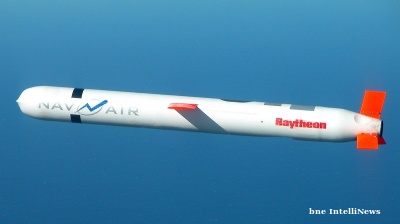Turkey’s calendar-adjusted industrial production index contracted for a sixth consecutive month in February, data from national statistics office TUIK showed on April 16.
However, the drop of 5.1% y/y was lower than the revised 9.9% y/y contraction recorded for December and the revised 7.4% y/y fall posted for January, driving hopes that Turkey might be pulling out of the recession it fell into at the end of last year.
The rosier data came on the same day that the Turkish finance minister and son-in-law of President Recep Tayyip Erdogan, Berat Albayrak, shared a photo on Twitter showing him in the Oval Office with US President Donald Trump, Trump’s son-in-law and aide Jared Kushner and US Treasury Secretary Steven Mnuchin.
A full readout of the surprise gathering—made possible by Albayrak’s presence in the US capital for the annual spring meetings of the IMF and World Bank and meetings with investors, which flopped—was never going to be available but the most concrete development that appeared to stem from it was comments from Turkish presidential spokesman Ibrahim Kalin made to reporters in Washington that Nato member Turkey expects Trump to use a waiver to protect it if the US Congress decides to sanction Ankara over a planned purchase of the Russian S-400 missile defence system.
Markets have been rattled by the prospect of the US imposing sanctions on Ankara if it does not back away from the purchase from the Kremlin but Kalin said that “if it comes to that, that is the sanctions proposed to be implemented by the Congress, of course we will expect President Trump to use his power for a waiver on that issue”.
Kalin conceded that Trump had not explicitly signalled he would issue a waiver, but with this US president anything is possible, of course. Such a presidential shield would no doubt help to settle market nerves over Turkey’s economic turmoil. For his part, Albayrak said: “[Trump] listened in a very reasonable way with a positive understanding of the process regarding Turkey’s needs for the S-400s. There was a very positive, constructive conversation.”
Poll expected industrial output fall of 6.5%
Prior to the industrial data release, a Reuters poll predicted a 6.5% y/y fall in the calendar-adjusted industrial output index for February.
The seasonally and calendar-adjusted index was in positive territory for the second consecutive month. It was up 1.3% m/m after a month ago registering growth, of 1% m/m, for the first time since July.
Citing Turkey’s latest economic readings, Albayrak told reporters on April 16 that Turkey had probably broken free of its first recession in a decade. However, analyst Timothy Ash at BlueBay Asset Management responded in a note to investors that such speculation was “a bit early” and—pointing to the unresolved S-400 row between Washington and Ankara—he added that “all this could be in vain if there is another big fall-out with the US on the S-400 front”.
In taking heart from the latest industrial output figures, officials are also overlooking the unsustainable loan growth financed by public lenders under government pressure along with booming fiscal expenditures, two moves that were put in place prior to the March 31 local elections, which nevertheless went so terribly wrong for the Erdogan administration with the defeats in Ankara and Istanbul.
Deceleration in retail slump
Also on April 16, TUIK data showed that Turkey’s calendar-adjusted retail sales contracted for a sixth consecutive month but at a decelerated pace of 4.9% y/y in February compared to the 6.3% y/y and the 8.8% y/y seen in January and December, respectively.
“It looks like March’s industrial data will show a further improvement. The rise in the manufacturing PMI in recent months [standing at 47.2 in March] is consistent with the year-on-year pace of contraction in industrial production easing further. Taking today’s figures together with retail data showing rising sales, it looks like the economy pulled out of recession in Q1,” William Jackson of Capital Economics said in a research note entitled “Economy past the worst”.
“It looks like the economy may have expanded by around 0.5-0.8% q/q. That said, the recovery is likely to be slow from here on. Activity in Q1 was probably boosted by pre-election stimulus, which is likely to fade. And financial conditions tightened towards the end of last month,” Jackson added.
“Last year’s sudden stop in the BoP gave rise to a severe credit crunch, cutting the current account deficit and reducing external vulnerability; the credit expansion in Q1 of this year undid a lot of that progress,” the Institute of International Finance (IIF) said on April 12 in a research note.
“State banks stepped in to fill the void, boosting Lira-denominated lending in Q1 of 2019, such that the positive credit impulse to the economy exceeded that in 2017. As in 2017, that focus on growth has had negative repercussions for the external picture, with import demand rising, which in turn pushed adjustment of the trade balance into reverse,” the IIF added.
The IIF estimates that the credit expansion is likely to have pushed the current account back into deficit in Q1, to the tune of -1.6% of GDP.
Turkey “arguably in a second sudden stop”
“In 2018 the natural stabilizer for the Turkish Lira was activity, which collapsed in the wake of the August ‘sudden stop’. We're arguably in a second sudden stop since late March, which is again weighing on GDP, reducing the current account deficit and stabilizing the Lira,” Robin Brooks of the IIF said on April 12 in a tweet.
However, the lira still seems under the control of the ‘invisible hand’ of officials that strive to set depreciation barriers. It has been knocking against the 5.80 threshold against the USD since April 12 after breaking the 5.70 and 5.75 barriers last week.
Following the renewed pressure on the lira, Turkey’s 5-year credit default swaps (CDS), a better tracker as they are set under free market conditions, moved up 12% w/w and 45% m/m to 441 on April 15.
“Our tracker of nonresident portfolio flows to Turkey continued to show outflows the week of April 5. These outflows are now larger than in May and August 2018. Turkey may be experiencing a second sudden stop,” Sergi Lanau of the IFF wrote on Twitter on April 12.
“Turkey's current account improved a lot since mid-2018. There was massive import compression, but its impact on the C/A was partially offset by weak exports. Income balance barely changed despite higher credit risk as only maturing liabilities roll at higher rates. Nonresident capital flows to Turkey recovered in Jan-Feb because strong inflows to bonds more than offset continued outflows from banks. Our high-frequency portfolio flows tracker suggests the picture from the full March balance of payments will be weaker,” Lanau wrote on April 14.
“The CBRT [central bank] tightened monetary policy in early April without a formal hike to then ease a bit. A durable solution to lira weakness and periodic market turmoil requires a full policy package. Fine tuning monetary policy is just a small step,” Lanau observed the day before.
Late liquidity window mystery
Meanwhile, mystery continues to surround the Turkish central bank’s operations. An unnamed bank or banks resorted to borrowing at the central bank’s Late Liquidity Window on April 15 for the first time since June, Reuters reported on April 16.
A single use of the facility is not concerning, but repeated use could point to liquidity problems and should be monitored, unnamed bankers told the news service.
The sub-components of the industrial production index for March portrayed the continuation of a broad-based deterioration in y/y terms as out of 24 manufacturing subsectors, 17 sectors registered y/y declines, Ozlem Bayraktar Goksen of Tacirler Invest said in a research note. She added that the foreign trade figures implied a prevailing weakness though at a slower pace in March.
Tacirler said it perceived that the course of Q1 pointed to another y/y contraction in GDP. However, in sequential terms, following the GDP declines in the final two quarters of last year, Tacirler expected a rise in Q1. “Yet, the pace and the sustainability of the recovery are of the utmost importance. The loan growth indicators have been showing that a rise prevails, which depicts the continuation of the improvement in April, so far.”
“The path of the Turkish Lira is tied to credit. The 2017 credit boom made the Lira vulnerable to the 2018 sudden stop. The subsequent credit contraction stabilized the Lira, until the Q1 2019 credit boom destabilized things again. That credit boom is now ending, a positive for the TRY,” Brooks added on April 12.
In other remarks on April 16, Albayrak claimed that the lira liquidity shortage that was seen in the London swaps market prior to the local elections was not orchestrated by the government. The government had simply acted in line with “free- market rules”, according to Albayrak.
Kushner, acting director of “Deal of the Century”
In further discussion of Albayrak’s day at the White House, analysts noted that Kushner serves as the acting director of Trump’s so-called “Deal of the Century” that is supposed to bring peace to the Middle East.
There were rumours that Albayrak did not manage to get an appointment to see Kushner when he visited Washington last year, but he shared photos of Trump’s son-in-law in Ankara when Kushner visited the Turkish capital in February.
There seems no rational way that Erdogan, who has attempted to portray himself as the decisive leader of the Muslim world, could back the “Deal of the Century” given Trump’s hugely disproportionate support for Israel versus the Palestinians and his brash moves to recognise Israel’s sovereignty over the Syrian Golan Heights and switch the US embassy in Israel to Jerusalem.
Erdogan regularly swaps insults with Israel PM and big Trump ally Benjamin Netanyahu, but perhaps he could ease up a little and not dismiss Kushner’s Middle East efforts out of hand should Trump do him an S-400s favour?
It’s all pure speculation of course, but Turkey watchers can find more solid ground as regards “well-informed” but unnamed sources who reportedly told Al-Monitor on April 15 that the US was pressing its Kurdish allies in Syria to ease their resistance to allowing Turkish forces to deploy on their side of the Turkish-Syrian border. That could be a sign that the US is moving to realise Trump’s pledge to Erdogan on placing Turkish forces in the planned safe zone in the northern Syria.
Reiterating the Turkish government’s view that Ankara does not believe Washington could countenance ‘losing Turkey’, presidential spokesman Kalin said during an event in Washington that he doesn’t believe the US would go down that path.
News

Mongolia’s PM ousted as party infighting topples government
Right to challenge sacking means battle may not be over. Observer says confrontation is linked to desire for control of country’s vast coal resources.

Ex-chairman of Istanbul-listed Sisecam hit with travel ban in Can Holding investigation
Company is controlled by "Ataturk" bank Isbank, which has previously been in the crosshairs of Turkish president Erdogan.

Ghana’s dormant TOR refinery to restart crude operations by October-end
Ghana has long struggled to translate its crude output into refined fuel security. Successive governments have pledged to revive TOR, which has faced years of debt, mismanagement, and technical breakdowns.

No Tomahawks for Ukraine, Trump to meet Putin in Hungary
The US cannot deplete its own stockpile of Tomahawk cruise missiles by supplying them to Ukraine, President Donald Trump said at a press conference on October 16 following a phone conversation with Russian President Vladimir Putin.



